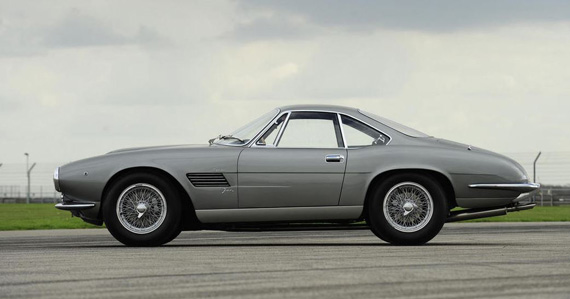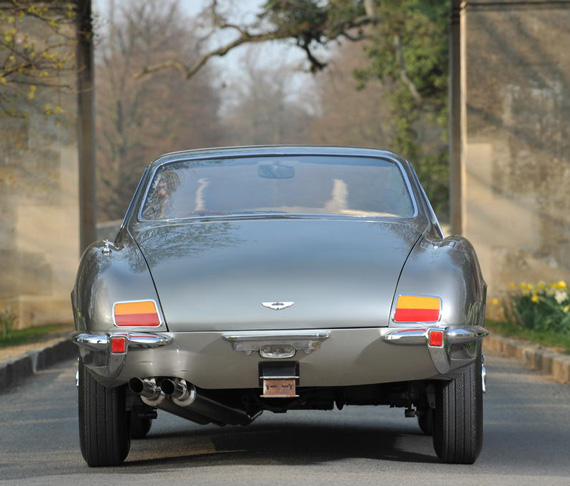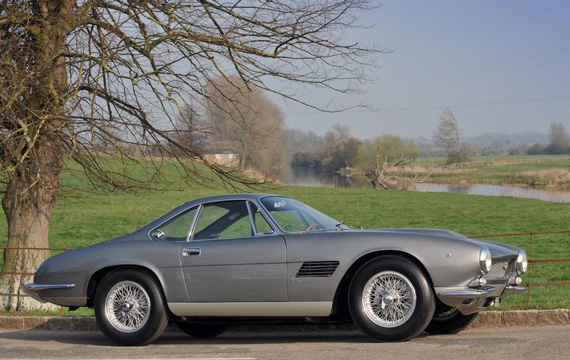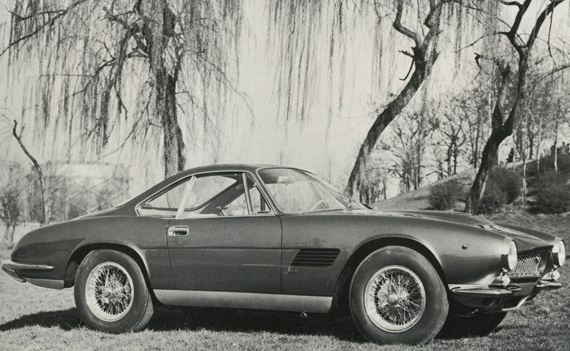By Wallace Wyss
Sometimes it’s the odd one that appreciates the most…
At one time, race cars were fetching a lot more at the major auctions than car show one-offs. The idea was that if you buy a race car, if you’re lucky you get one with history. You buy a show car, a one-off what do you get? A momentary bauble. A flavor of the moment as it were. Designs that came and went, mostly forgotten.
Well this 1960Aston Martin DB4 GT Bertone Jet coupe, chassis 0201L, Engine no. 370/-201/GT was sold at a May, 2013 Bonhams auction for the top dollar sum of 3,249,500 GBP ($4,928,697 USD) which is more than some Aston Martin DB4GT race cars go for even with some racing history.
There is a reason for this. This particular car was the last DB4 GT chassis—and the last of any series is worth more than the ones in the middle.
First a little bit about the Aston Martin DB4 GT as a model. “DB” means “David Brown” by the way, he being the owner of Aston after WWII. The DB4GT was introduced as the competition version of the DB4 sports saloon. First launched in in 1958, the Aston Martin DB4 was a direct challenge to Ferrari. It had an all new steel platform chassis with disc brakes all round, and a race-developed twin-cam six-cylinder 3.7-litre engine, all clothed in a perfectly proportioned aluminum body designed by Touring Superleggera of Milan.
Engineered by Harold Beech, the immensely strong platform-type chassis had Touring’s Superleggera body which used a lightweight tubular structure to support hand-formed aluminum body panels. The front suspension employed unequal-length wishbones while the rear was live axle located by Watts linkage.
But the factory quickly realized they needed a lightweight version for racing, that model, the DB4GT, making its debut at the 1959 London Motor Show. The lightweights had 5″ chopped out of the wheelbase and replaced the rear seats with a luggage platform on all but a small number of cars. Even the bodywork was thinner aluminum, which contributed to 200 lb (91kg) less weight than in the street model.

Oddly on the front the front bumpers seem to be at angle just to accommodate turn signals. Wasn’t there a better solution? Credit Bonhams Auction.
On this Comp version, it had a few changes from the touring car, such as faired-in headlamps with Perspex covers, a feature later made standard on the DB5 and DB6. The rear screen and quarter windows were Perspex (Plexiglas) on many examples; bumper over-riders were deleted and the wind-down windows were frame-less within the doors. Twin Monza quick-fill competition fuel fillers were added atop the rear fenders, and a large-capacity fuel tank mounted flat in the boot. GTs were fitted as standard with lightweight Borrani 42-spoke wire wheels with alloy rims and three-ear ‘knock-offs’.
Piloted by the likes of Roy Salvadori, Stirling Moss, Jim Clark and Innes Ireland, the DB4GT model did well. Only 30 were produced in left-hand drive configuration.
The Aston Martin DB4GT was another variant, bodied in Italy by Zagato and those have become the most sought after of the DB4GT cars.
This particular car, chassis 0201L, was ordered by Bertone to be the carrozzeria’s show car for the 1961 Geneva Motor Show. The design Giugiaro had put on paper wasn’t just a bolt-on, the whole wheelbase had to be shortened five inches. The body that went on was steel even though someone somewhere is saying it was 200 lbs. lighter than the aluminum-bodied production car (possible, when you consider the weight savings of cutting out five inches of length.)
The car did its time at the auto show where it was celebrated (though some seem to think the Giugiaro-designed Bertone-bodied split grille Ferrari 250T swb coupe a more memorable design, done the same year.)
The engine was tweaked a bit, still an inline six twin-cam displacing 3.7-liters but producing 302 bhp (225 kW) at 6,000 rpm as a result of switching to three Webers, a sizable jump from the standard 240 bhp (179 kW) output. The car would go 0-60 mph in 6.1 seconds and top end was 153 mph.
Upstaged by the E-Type
One reason the Jet coupe did not get much publicity at the time it was first shown was because it had the misfortune of being unveiled in 1961 at the Geneva show just as Jaguar rolled out the E-type, which was arguably a very seductive shape at less than a third the price of an Aston Martin. So the press sung the praises of the Jag and the Aston was ignored. Timing is everything.
And then the Aston disappeared into the sands of time. Some say it was in Beirut. Then it went to America where it didn’t fare too well. An engine fire scorched the bonnet and engine compartment and then, through poor storage, the body actually rusted because the body was made of steel, not aluminum.

At first, it appears to be doing fine. But gaze on it for a while, and the proportions eventually fail. Credit Bonhams Auction.
The Rescue
Who should rescue it? None other than the Chairman of Aston Martin at the time, Victor Gauntlett. He brought it back to Blighty, hand had his shop re-do it, which involved much rust repair and hand fabrication of various one-off bits.
The car was midway through restoration when Hans-Peter Weidmann discovered it and bought it in 1988 and the car was finished for him. He drove it quite a bit, accumulating 35,000 miles, one time telling OCTANE magazine that he did 950 miles in one day across the U.S. and part of Canada (surpassing the author’s own epic trip of 750 miles in one day but I am sure Hans-Peter was driving a car considerably more entertaining).
When Weidmann passed on, the family brought it to Bonhams in 2013, who fetched that extraordinary amount.

Taillights appear custom made. Rear roofline suggests a little of the PF Ferrari 400 Superamerica. Credit Bonhams Auction.
Your author feels the outsize amount, more than some DB4GTZ cars were selling for at the time, was due to the fact that it is an example of “early Giugiaro,” i.e. the work of then young designer Giorgetto Giugiaro, who toiled at the boards at Bertone while still in his 20s, creating a surfeit of memorable designs. Other one-off Giugiaro cars like the Maserati Boomerang, have also fetched large amounts because they are one-offs that were well remembered show cars.
Lesson to be learned here? One-off show cars, however obscure, can be good long range bets. That’s because a lot of those scrambling to buy a factory race car –particularly a Zagato-bodied DB4GTZ – walked right on by this show car, figuring it just to be a show car bauble. Also in this case Giugiaro was becoming ever more famous, and is now recognized as the most brilliant designer of the Sixties to come out of Italy. Lesson No. 2: Buying a car that has had a fire sounds scary but the truth is that there are fires and there are fires. Maybe the fire in this was confined to the engine compartment. True, some of the small trim parts were irreplaceable, which means you can get them made again but it’s going to cost an arm and a leg. But remember, it sold for almost $5 million, and I’m sure there was enough profit in there to re-make all the little parts that had to be fabricated.
Now it’s possible the general public wouldn’t have known about this car sitting in obscurity, but it’s logical that all news funneled to the man at the top, helped by the fact that Gauntlet was reportedly a true car nut and Aston enthusiast. This car is destined for my next Incredible Barn Finds book if I can find anyone that knows how Gauntlett found it, or what it could been bought for in that condition. Odds are, once this book is published, I’ll find out that others knew of the car sitting around in America, in the back of some shop with not one enthusiast who saw it willing to tackle a car that was an edition of one, with no spare body parts and a blackened lump under the bonnet.
Not only did Hans-Peter buy it but it sounds like he had a helluva lot of fun with it. I envy first his “eye” for recognizing the car’s pedigree and then the fun he had in driving a one-off Giugiaro grand touring creation built on such a great race-bred platform. He drove it further than most any barn find purebred I’ve heard of. I would venture to say he got full use of it (take that, you fellows who are scared to take your classic car out for fear of “road rash”).
Lesson learned here? Don’t pass up those “ugly ducklings” –the one-offs that people pass up on their way to pay full boot for a race car with history. Sometimes the “ugly duckling” grows more beautiful in time, as this Aston certainly did.
THE AUTHOR: Wyss’ current book, Incredible Barn Finds, is available from the publisher, Enthusiast Books at 715 381-9755.


Calling this vehicle an “ugly duckling” is mortal “sin”. I had the pleasure of owning another unsuccessful, but beautiful early Giugiaro design, the ASA 1000 (Ferrarina).
We were second in class to this car at Bagatelle in ’92, but I’m confused. I woulda sworn the car had “nostrils” like the similar Ferrari. But of course old memories in an old brain play tricks. But the rear end photo throws me: The car I saw had a license-mounting plate with some of the flat black paint flaking off. And I’d bet a cookie the taillight lenses were solid red–with some of their coloring flaking off internally too. I wondered why such little details weren’t attended to, and believe me I’m no concours sort of guy. Herr W. told us (or gave us a card or both) he owned a pharmaceutical company in Bern. Our Bristol 407 Zagato had a chance at the “golden rooster” award given, I think, as an award separate from the class award, until we were told to fire up our engines. A Yurrupean straight six sounded more sporting to the judges than our Chrysler 318 V8. I even thought so myself!
p.s. The proportions don’t “fail” to me. That short-coupled rear looks very sporting to me. That’s why there are chocolate and vanilla and why I’m a voice crying in the wilderness to car magazines to eliminate any styling considerations in their evaluations of new cars. Each buyer determines what looks good to them. If they’re “uneducated,” so what; as long as THEY like their new car.
That side profile also just ‘fails’ for me too; not in a total disaster deal-breaker kind of way, (although I would have been half a million dollars short of making a deal anyway) it looks just not quite RIGHT.
From all other angles, I am happy with it, and part of the problem with reading the story first and then coming to that side profile photo is that one is already expecting some kind of Aston DB4 and the super-short wheelbase coupled with a substantial rear overhang trick the eye into thinking there is something wrong with this Aston.
If it had slightly smaller wheels however, or at least lower profile tires, making it sit down a bit, then we could appreciate proportions that possibly would remind us more of one of Moretti’s jewels, rather than a fast truck from Newport Pagnell.
Toly’s second comment above brings up a very relevant point which for some reason had never occurred to me before – so no, Toly you are not alone, now there are two voices in the wilderness.
Too many journalists and commentators in the auto world these days see themselves as qualified to pontificate on that great unquantifiable concept; STYLE.
There are very few who can carry it off, and in road tests and magazines reviews let the journo’s stick to measurable facts, performance, size, weight, capacities, dynamics, and the rest and leave the personal question of how good a car looks to the eye of the beholder.
Of course there has to be a disclaimer to that, just to allow us to continue to debate such intangibles on VeloceToday.
Bertone did a great job on this design but I’m surprised as I thought Aston was not fond of having Italian designs on their chassis. The 3 Arnott Aston DB2/4 cars were limited I thought because Aston did not want to have any of its cars bodied by the Italians so Arnott had to go to Bristol for chassis. As a side note the winner of this years’ Pebble Beach Aston Martin class was one of those Bertone bodied cars.
Hey, guys, I’ll try to defend a writer making styling comments. I agree that beauty is in the eye of the beholder, but I base my right to make design comments on the fact that I’ve been an auto reporter since 1965, invited to many a preview (even driving prototypes) where I was expected to comment on the design to readers. Let’s throw an “ageist” (sp?) rule in there that only young wet-behind-the-ears reporters can’t comment on styling because they don’t have the memory of decades of design. But there’s one design area where I will confess I now have trepidations commenting on–that is new cars where we only see the pictures. I remember when t he 458 Italia came out I did a design critique based on pictures and then when I saw the real car was embarrassed that there was some world class trickery at the rear with a built in spoiler & vents underneath, etc. that I had missed in the photos. Plus the car had a real presence in person. So I’ll try to hold off on commenting on the design of new cars until I see them in person.
The rear end reminds me of a certain BMW, not sure which one it was. Everyone likes what they like but I wouldnt go as far as to say writers cannot express opinions on styling. As for a voices crying in the wilderness, could be a babe in the woods but I would rather be a lion in winter. Whatever that means,lol
I like “could be a babe in the woods but I would rather be a lion in winter.” I don’t know what it means but I will save it along with other phrases I haven’t figured out yet like “cock a snoot” . Looking at the pictures again, there’s a certain Triumph TR6 look to the front, not good for an expensive car like an Aston.